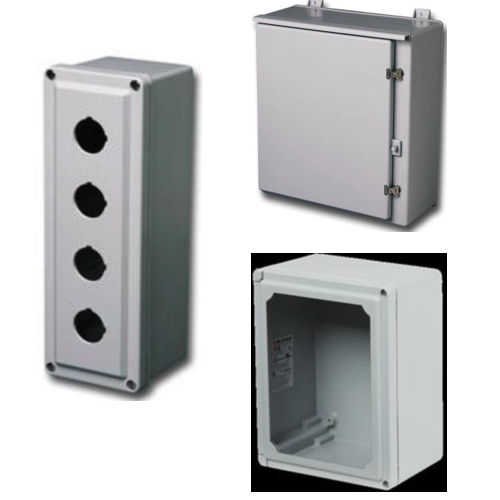Stahlin Fiberglass Enclosures

Stahlin non-metallic fiberglass enclosures are engineered for demanding industrial environments where corrosion resistance, durability, and electrical insulation are critical. Manufactured from fiberglass-reinforced polyester (FRP), these enclosures provide exceptional resistance to chemicals, moisture, UV radiation, and harsh outdoor conditions. Their rugged construction makes them suitable for both indoor and exterior installations across a wide range of industries.
A key advantage of Stahlin fiberglass enclosures is their non-conductive design, which enhances safety in hazardous or electrically sensitive applications. Lightweight construction simplifies handling and installation while maintaining structural strength and impact resistance. Stainless steel hardware is used throughout the enclosure designs, ensuring long-term reliability and resistance to rust or corrosion even in aggressive environments.
Stahlin offers fiberglass enclosures in a wide variety of sizes, shapes, and configurations, including hinged-cover designs that allow safe and convenient access for maintenance and system modifications. These enclosures are commonly used to protect electrical and instrumentation components in industrial manufacturing, utilities, wastewater treatment, chemical processing, and infrastructure applications. Thoughtful design and material selection help ensure long service life and dependable protection for sensitive equipment.
FAQs
Q: What are Stahlin fiberglass enclosures made from?
Stahlin fiberglass enclosures are constructed from fiberglass-reinforced polyester (FRP), a thermoset material known for its strength, dimensional stability, and resistance to chemicals and environmental exposure.
Q: Are Stahlin fiberglass enclosures suitable for outdoor use?
Yes, many Stahlin fiberglass enclosures carry NEMA 4X ratings, making them suitable for outdoor installations where protection from water, dust, and corrosion is required.
Q: Can Stahlin fiberglass enclosures be used in hazardous locations?
Stahlin fiberglass enclosures are non-conductive and highly resistant to corrosion, making them well suited for hazardous and electrically sensitive environments when properly specified.
Q: What temperature range can fiberglass enclosures withstand?
Fiberglass enclosures typically offer a wide operating temperature range, approximately -31°F to 300°F, depending on the specific enclosure design.
Q: How do fiberglass enclosures compare to other non-metallic materials?
Fiberglass offers high impact strength, excellent chemical resistance, superior electrical properties, and a wider temperature range compared to materials such as polycarbonate, ABS, or polyester.
Why Buy Stahlin Non-Metallic Fiberglass Enclosures from RSP Supply
RSP Supply offers a complete selection of Stahlin non-metallic fiberglass enclosures and junction boxes to meet demanding industrial requirements. Our lineup includes multiple sizes, configurations, and NEMA-rated options designed for long-term performance in harsh environments. Customers rely on RSP Supply for knowledgeable technical support, dependable sourcing, and enclosure solutions that protect critical electrical and instrumentation systems.

